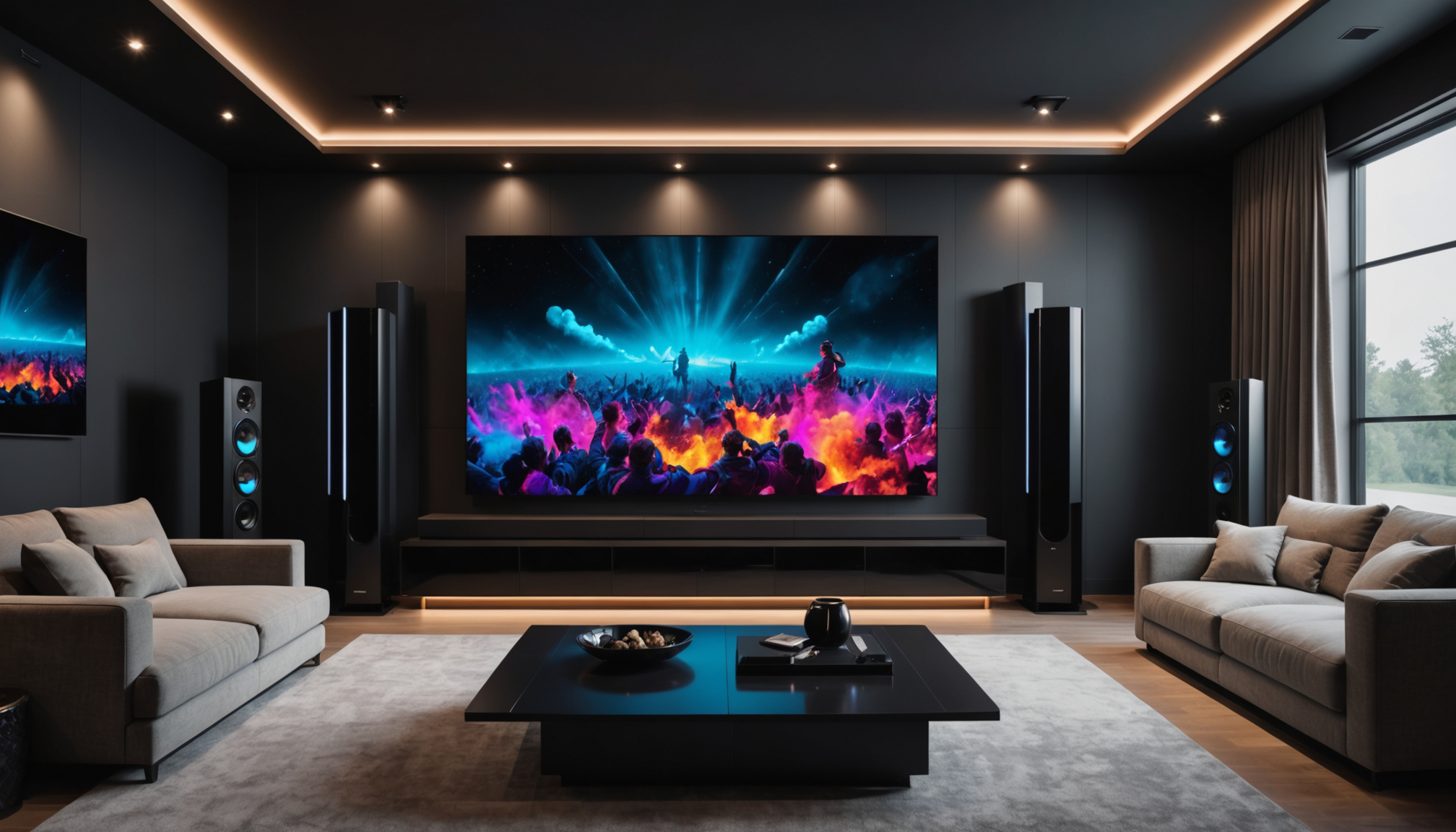Embarking on the journey of installing an audio/visual system can be both exciting and overwhelming. Before diving into the specifics of what your setup will include, it’s crucial to start by understanding your unique audio/visual needs. This foundational step not only helps in making informed decisions but also significantly influences the overall cost and effectiveness of the installation.
Firstly, consider the primary purpose of the audio/visual system. Are you aiming to create a sophisticated home theater environment, or are you more interested in integrating a versatile audio system throughout your smart home? Perhaps your goal is to enhance boardroom presentations in a corporate setting. Each scenario requires different specifications, which will guide the selection and installation process.
It’s essential to evaluate the spatial characteristics of the intended area for your audio/visual setup. Factors such as room size, acoustics, and seating arrangements all play a pivotal role. A larger room may necessitate higher audio output or additional speakers, while smaller, intimate spaces might benefit from specialized acoustic treatments to enhance sound quality. Similarly, a smart home environment might require wireless solutions that are compatible with existing systems.
Engage with the technical aspects by considering the types of equipment you’ll need. This includes projectors, screens, sound systems, and connectivity solutions. Consider whether you prefer sleek, minimalist setups often seen in modern home theaters or more robust systems tailored for high-performance audio and visual experiences. Utilizing the best technology suited to your requirements can enhance functionality and offer connectivity options that align with a modern, smart home experience.
Once you’ve outlined these needs, think about the level of user interaction you’re comfortable with. Some users may prefer simple, user-friendly interfaces, while others might welcome more complex systems with multi-functional capabilities. A smart home integration, for example, might involve voice control features, app-based operation, and integration with other smart devices throughout your living spaces.
Tangible requirements can be broken down as follows:
- Sound Quality: Determine whether you’ll require basic stereo sound or a more advanced surround sound system.
- Visual Display: Decide among LED, OLED, or projection based on room conditions and viewing preferences.
- Connectivity: Consider the need for wireless versus wired connections, and the compatibility with existing smart home systems.
Lastly, assessing your needs should include a strategic approach to budgeting. Understand the potential costs associated with various configurations. Consider the expenditure balance between initial setup costs and potential ongoing maintenance or upgrades. By clearly defining these attributes upfront, you stand to achieve an optimal blend of performance and cost-effectiveness that meets your current and future requirements.
| Factors | Budget-Friendly Option | High-Efficiency Option |
| Sound Quality | 2.1 Channel System | 7.1 Surround System |
| Visual Display | LED TV | 4K OLED or 4K Projection |
| Connectivity | Basic Bluetooth/Wi-Fi | Integrated Smart Home Management |
A comprehensive understanding of your audio/visual needs ensures a seamless installation process, maximizing both performance and satisfaction. This foresight not only enhances current enjoyment but also lays the groundwork for any future enhancements or upgrades you might wish to explore.
Setting a realistic budget
Creating a realistic budget for your audio/visual system installation is a critical step in ensuring that your project not only meets your current needs but also aligns with your financial capacity. Here’s how to effectively set and manage your budget:
1. Determine Your Spending Limit: Begin by evaluating your financial situation and determine how much you can comfortably allocate. This encompasses understanding both the initial installation cost and any ongoing expenses that might arise from maintenance or upgrades.
2. Prioritize Essential Components: Identify which components of your audio/visual system are essential and which are optional. For a home theater, a high-quality display and sound system might be prioritized over complex smart home integrations. Create a list of must-haves and nice-to-haves to guide your purchasing decisions.
3. Research Costs: Engage in thorough market research to understand the price ranges for your desired equipment. Compare prices from various retailers, and be on the lookout for sales or package deals that can offer significant savings.
4. Allocate Funds by Component: Allocate specific portions of your budget to different system components. For instance, designate a percentage of your budget to audio equipment, another to visual displays, and a separate allocation for connectivity solutions. By categorizing funds, it becomes easier to manage costs without overspending in any area.
5. Consider Professional Installation: While some installations can be DIY projects to save money, others might require professional expertise. Evaluate the complexity of your system and decide if hiring a professional is necessary to ensure optimal performance and avoid costly mistakes. Factor this potential cost into your budget.
6. Plan for Hidden Costs: Don’t overlook ancillary expenses such as cables, mounts, or stands, which are crucial for installation but can add up quickly. Also, consider any modifications that might be required for your space, such as wall reinforcement for heavy equipment or wiring services.
7. Factor in Future Upgrades: While your current needs dictate today’s budget, foresight can save money in the long run. Consider whether future upgrades could be accommodated under your current system architecture, and plan to preserve funds for these enhancements.
8. Review and Adjust: Periodically review your budget throughout the planning and installation process. Being flexible and willing to adjust allocations or downgrade features if you’re approaching your financial limit can keep the project financially stable.
By following these structured steps, you can confidently manage your budget for an audio/visual system installation, ensuring a balanced approach that prioritizes essential features while staying within your financial means. This methodical planning not only helps in avoiding unexpected financial strain but also maximizes the value and longevity of your home theater or smart home integration.
Exploring equipment options
When it comes to selecting equipment for your audio/visual system, a well-rounded understanding of the available options can significantly enhance your setup while staying within your financial plan. Exploring various equipment choices not only helps tailor the system to your needs but also allows you to optimize both cost and performance effectively.
Begin by evaluating your audio components. For sound systems, you’ll find a wide spectrum of options ranging from basic stereo setups to sophisticated surround sound systems. Investing in a high-quality audio system is paramount, especially if your aim is to replicate a cinema-like experience in your home theater. Consider brands and models that offer clear dialogue, a rich frequency range, and immersive sound stages. If your priority is a smart home audio system, explore options that offer seamless wireless connectivity and integration with voice-activated devices, ensuring that your entire environment functions cohesively.
Next, focus on visual display technologies, which are integral to a captivating viewing experience. Contemporary choices include LED, OLED, and projection systems, each with unique benefits and cost considerations. LED and OLED televisions often offer vibrant colors and excellent contrast ratios, making them ideal for rooms with controlled lighting conditions. For those seeking a cinematic projection system, look for projectors with high lumens and resolution, such as 4K, which deliver sharp, lifelike images on large screens. Factor in the costs associated with screen materials and mounting solutions, aiming for options that maximize visual performance without exceeding your budget.
Connectivity solutions form the backbone of any modern audio/visual system. Whether wired or wireless, the choice should align with your lifestyle and existing home infrastructure. Ensure the compatibility of your components with smart home ecosystems if integration is desired. Devices that support HDMI ARC or eARC, Bluetooth, Wi-Fi, and smart assistants (like Alexa or Google Assistant) simplify connections and expand interoperability. Investing in future-proof technology that supports upcoming standards can save costs down the line and prevent the need for frequent upgrades.
Evaluate all options with an eye toward customization and user experience. Some people may prefer minimalistic systems that blend into their home décor, while others might prioritize high-functioning setups that boast advanced control options. Companies offer customizable features that allow you to tailor audio output, display settings, and user interfaces to your precise preferences, enhancing the overall enjoyment and functionality of your installation.
Thorough research is essential. Compare different brands and technologies, reading reviews and seeking demonstrations where possible, to gain firsthand insights into performance and usability. Keeping abreast of current technology trends can also illuminate emerging products that deliver enhanced features and cost efficiencies. This strategic approach to exploring equipment options will not only keep your expenses in check but also ensure the finished installation delivers a sophisticated and satisfying audio/visual experience tailored to your unique needs and future aspirations.
Installation tips and best practices
For a seamless audio/visual system installation, it’s essential to consider a blend of expert insight and practical steps to ensure your project progresses smoothly and without unnecessary complications. Installing your system should enhance your entertainment experience, whether evolving a space into a sophisticated home theater or integrating an efficient smart home network.
Begin with a strategic layout plan. Determine where screens, speakers, and control systems will be placed in relation to seating and room acoustics. Conducting a sound test in your space can help identify optimal speaker placement to ensure even sound distribution and minimize echoes or dead zones. Use specific tools and apps designed to measure room acoustics and adjust settings accordingly.
Cable management is a crucial, yet often overlooked aspect of system installation. Proper cable management not only maintains a clean and organized appearance but also ensures the safety of your setup. Labeling cables and using cable management solutions, like channels or sleeves, will simplify any future maintenance or rearrangements. For those looking to achieve a wireless aesthetic, investing in wireless audio and visual solutions can be both a practical and visually pleasing alternative.
When mounting displays, consider the viewing angle and height to optimize comfort. Displays should generally be at eye level when seated, reducing strain and enhancing the viewing experience. Ensure that any wall mounts or brackets used can support the weight of your equipment, and make sure they are securely fastened to avoid accidents or equipment damage.
Calibration is another key aspect that should not be overlooked. Calibrating your display settings for brightness, contrast, and color ensures that the visual output is accurate and optimal for your room’s lighting conditions. Meanwhile, calibrating audio settings helps to deliver crisp and dynamic sound quality tailored to your preferences and space layout. Many systems offer automatic calibration features, which can be supplemented with manual adjustments for a personalized touch.
Security should also play a part in your checklist. Especially if integrated into a smart home system, ensure all connected devices have updated firmware and are secured with strong passwords to prevent unauthorized access. Consider using network firewalls or security protocols designed specifically to protect smart home devices.
A test run of the entire system is critical before finalizing installation. Play various types of media to evaluate the performance of both audio and visual components, checking for any issues such as lag, buffering, or audio sync problems. Making adjustments at this stage can save you the hassle of troubleshooting later.
Remember, if at any point the installation process feels challenging or beyond your expertise, consider hiring a professional. A skilled installer can provide insights that might not have been considered and ensure that your system is set up for optimal performance. This investment can save time, reduce stress, and safeguard against costly errors.
Finally, for those looking to find trusted professional help or additional resources, sites like LocallyFind.com can be invaluable. This home services directory connects you with experienced professionals in your area, ensuring that your audio/visual projects receive the attention and expertise they deserve.
Through careful planning and attention to detail, your installation can transition from a daunting task to a satisfying achievement, transforming your space into an immersive haven tailored to your entertainment desires.
Planning for future upgrades
Planning for the future is a crucial aspect of any audio/visual installation, ensuring the system remains effective as technology evolves and your needs change. As you lay the groundwork, consider how your current setup can adapt to future technological advancements and personal preferences. This foresight will save you not only time but also significant costs down the line.
One of the primary considerations is ensuring that your audio/visual system has the flexibility to integrate new technologies. For instance, as smart home integrations become increasingly advanced, your system should be compatible with emerging platforms and devices. Choose equipment that supports over-the-air updates or modular components, which can be easily upgraded without replacing the entire system. This approach allows you to keep pace with advancements in high-definition displays, immersive sound technologies, and connectivity standards, such as HDMI 2.1 or future wireless communication protocols.
Additionally, prioritize scalable solutions. When planning speaker systems, wiring, or placements, consider the potential to expand. For example, a home theater might initially be set up with a basic surround sound system, but leave room for additional speakers for a more immersive experience as your budget allows or technology improves. Likewise, in a multi-room setup, ensure that your network infrastructure can handle the addition of extra audio zones without a significant overhaul.
It’s also wise to invest in high-quality cables and connectors at the outset. While they may seem like minor components, they can significantly affect the performance and expansion capabilities of your system. By selecting products with high bandwidth and robust durability, you position yourself to accommodate upgraded equipment with minimal hassle.
Maintaining detailed documentation is equally important. Keep a comprehensive record of your system’s specifications, including model numbers, software configurations, and installation layouts. This information is invaluable when planning upgrades or troubleshooting issues. Consider creating a digital home hub for your smart home devices, where you can manage and update system configurations seamlessly.
Finally, stay informed about industry trends and innovations. Regularly review tech publications, attend expos, or join forums to gain insights into future-ready technologies that could enhance your system’s capabilities. By remaining proactive, you can make informed decisions that align with your long-term vision.
In conclusion, careful planning and strategic investments in your audio/visual system pave the way for a future where technology seamlessly aligns with your evolving lifestyle. By taking steps to understand your needs, setting a budget, exploring equipment options, and following best installation practices, you’re set up for an audio/visual setup that not only meets your current desires but also adapts to tomorrow’s innovations. Keep an eye on future upgrades, and your system will continue to deliver impressive performance and enjoyment for years to come.


